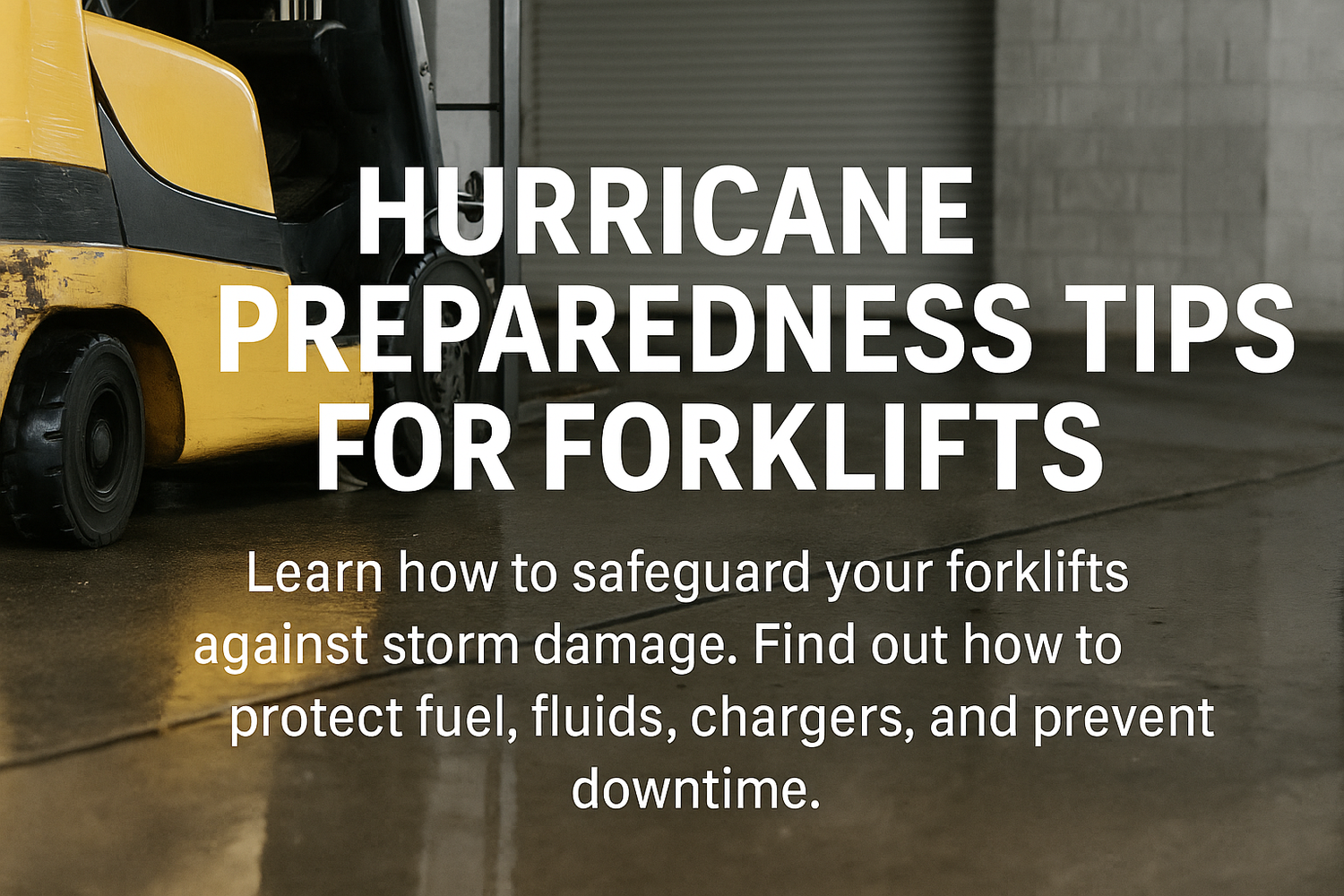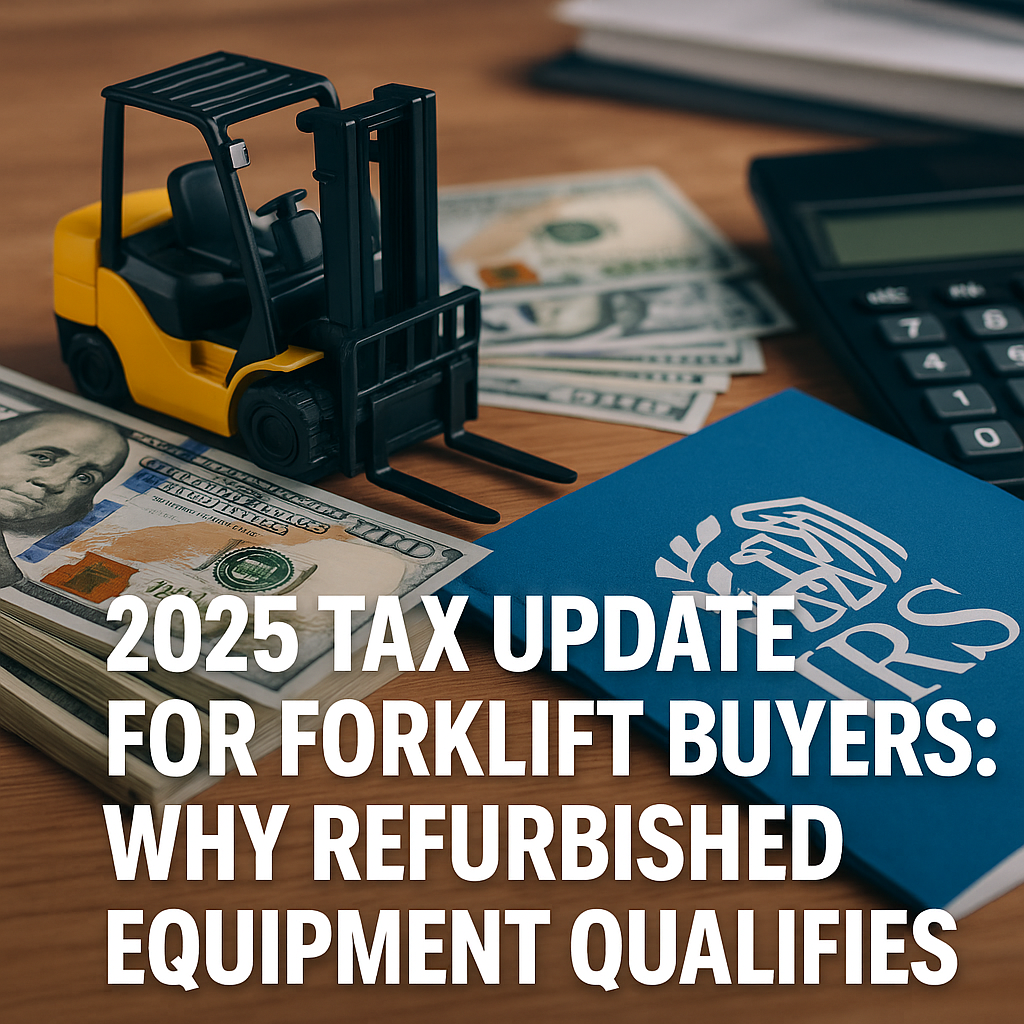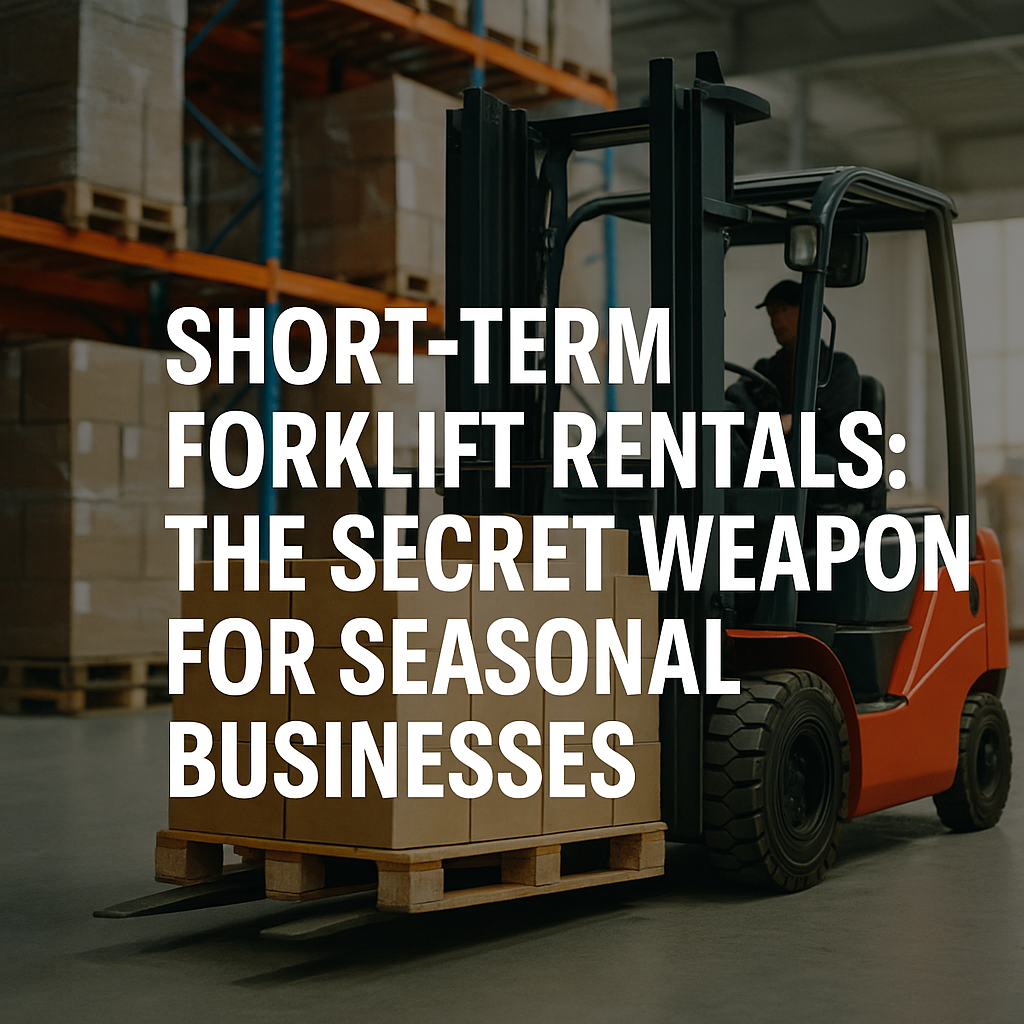Atlantic hurricane season runs from June 1 to November 30. That includes the U.S. East Coast. Activity usually peaks from mid-August through mid-October, with a mid-September maximum. Forklifts need a clear plan. This merged guide covers storage, flood protection, fuel, fluids, chargers, inspections, and safety. Short sentences. Practical steps. Built for teams that can't afford downtime.
Why forklift hurricane preparedness is non-negotiable
Forklifts are the backbone of material handling. When they stop, the operation slows or stops with them. Hurricanes bring wind, water, debris, and outages. Each hazard hits forklifts hard. Water contaminates oil and hydraulic fluid. Salt spray accelerates corrosion on chains, pins, and wiring. Power loss interrupts charging. Filters clog from dirty fuel. Unsecured fuel and cylinders add risk.
The fix is planning. Not pages of theory. A short playbook. Move. Protect. Power. Inspect. Restore. Practice once before peak season. Assign roles. Keep the steps visible on the floor. That turns chaos into a checklist.
Know your window
Watch local forecasts. When your county is under a watch, begin relocation and protection. Do not wait for a warning. Traffic builds. The best storage spots vanish. Early action wins and costs less.
Hurricane readiness for forklifts: start now
Relocate what you can. Protect what you can’t move. Elevate anything near floor level. Secure fuel. Power down and unplug chargers. Photograph the equipment and areas before the storm. Label and tag gear so anyone can follow the plan if leadership isn’t on site.
Move forklifts out of flood risk
Identify high ground on site. Prefer interior areas away from doors, drains, and low docks. If surge maps show risk, move assets inland before landfall. It is cheaper to shuttle equipment than to replace controllers, motors, or masts.
For step-by-step relocation and flood protection tactics, see our guide: How to Protect Your Forklift from Flood Damage.
Cover, elevate, and seal
Use heavy waterproof covers. Strap them tight. Focus on control heads, dashboards, engine bays, and battery compartments. Elevate chargers, junction boxes, and power strips on pallets or racks. Keep cords off the slab to reduce wicking. Store propane cylinders and fuel well above any projected flood line. Cap and close valves. Use rated containers only. Label clearly.
Position for a clean restart
Lower forks to the floor. Set the mast vertical. Engage the parking brake. Chock wheels on slopes. Remove keys and tag the unit. Record each storage location to speed post-storm checks and insurance documentation. Photograph the serial plate and hour meter.
Electric vs. internal combustion: special risks
Electric forklifts. Even shallow flooding can wick into battery cables and contactors. If water touched the battery or charger, isolate and tag out. Do not energize until a qualified tech inspects it.
LP/gasoline/diesel forklifts. Water sneaks into tanks and filler necks. Contaminated fuel stalls engines and can damage injectors. Keep tanks sealed and elevated. Cap cylinders and close valves. Verify label and storage compliance before the storm.
Fuel and fluids: mission-critical details
Fuel quality decides uptime during and after a storm. Heat and humidity pull water into tanks. Microbes thrive. Filters clog. Generators sputter. Forklifts won’t start when you need them most. Plan ahead: test, treat, rotate, and stock filters.
Test and treat fuel
Use water-finding paste to check diesel storage. Drain water bottoms. If growth is suspected, dose with a biocide per label. Keep spare filters and a posted changeout procedure. Two clear primers from Bell Performance: Fuel Security for Hurricane Season and Seven Critical Steps for Emergency Fuel Management.
Hydraulic fluid and engine oil
Water turns the hydraulic fluid cloudy or milky. Lubrication drops. Heat rises. Seal life shrinks. After exposure, check sight glasses and pull samples. If the fluid looks off, flush and refill. If engine or transmission oil looks milky, change it immediately and replace filters. Run briefly and re-check. Repeat if needed.
We handle full hydraulic service and rebuilds in Orlando and Raleigh. Learn more: Hydraulic Cylinder Rebuilds and Hydraulic Pump Rebuilds.
Backup power and charger safety
Plan for outages. Test your generator under load before the storm. Never run a generator indoors or near air intakes. Carbon monoxide kills quickly. Follow Ready.gov power outage guidance for safe setup and use.
For electric fleets, unplug chargers before the storm and open the breaker. Elevate the charging gear above the waterline. After flooding, do not re-energize until a qualified technician confirms the equipment is dry and safe internally.
During the storm: what not to do
Do not operate forklifts in high winds or standing water unless life safety demands it. Water hides debris, holes, and energized hazards. Do not charge wet batteries. Do not energize a charger that has sat in water. Keep floors clear to reduce slip and collision risk. See OSHA’s employer guidance: OSHA Hurricane Preparedness and Emergency Preparedness — Getting Started.
After the storm: inspect before you start
Begin with safety. Walk the floor. Look for downed lines, damaged racks, and slick surfaces. Control access. Keep non-essential staff out. Wear gloves, boots, and eye protection. Compare conditions against your pre-storm photos. Log everything.
Step 1: Isolate power and batteries
Any unit that might be wet gets isolated. Pull the battery connector on electrics. Tag the steering wheel. If salt water was present, corrosion starts fast. Do not attempt a DIY dry-out or charge. Schedule a professional inspection.
Step 2: Check every system for water
- Electrical: Open panels. Check harnesses and connectors. Dry with fans and contact cleaner. Avoid high heat near batteries or boards.
- Engine/Transmission: Pull dipsticks. Milky or foamy oil means water is inside. Change oil and filters immediately. Run briefly and re-check.
- Hydraulics: Inspect fluid. If cloudy, drain and refill. Cycle cylinders after refill to purge lines. Check hydraulic hoses for bubbles, cuts, soft spots, or rusted ferrules.
- Mechanical: Wipe and re-lube chains. Check equalization. Inspect pins and retainers. Look for drift, chatter, or uneven lift during testing. Check fork heels for wear and cracks.
Step 3: Dry, test, then return to work
When systems are dry and fluids corrected, perform a no-load start. Watch for warning lights. Listen for knocks or grinding. Verify steering, brakes, horn, lights, and hydraulics. Then test with a light pallet in a clear area. If normal, return to service and re-check after the first hour.
For deeper guidance on the restart sequence, see our post-storm notes: Key Steps for Inspection and Repair.
Protect the warehouse, not just the forklifts
Floodwater ruins inventory fast. Move critical goods off the floor before landfall. Keep aisles open for drainage and emergency access. Strap lightweight items that can blow into equipment. Check dock door seals. Clear drains and sumps. Stage sandbags as needed.
Racking must be anchored per the manufacturer's specs. Verify anchors and braces now. After the storm, if you see lean or sway, take the bay out of service and call a racking engineer or contact us for a referral. Do not load questionable bays until inspected.
Documentation, insurance, and continuity
Photos matter. Take pre-storm and post-storm shots of every unit and area. Capture serial plates and hour meters. Keep PM records handy. Document fuel treatment steps and fluid changes. These speed claims and support replacement or repair decisions. Maintain a simple continuity plan: alternate dock, alternate staging area, and vendor contacts.
Spare parts and supplies that pay off
- Fuel filters, oil filters, hydraulic filters, belts, brake cleaner, contact cleaner.
- Biocide and water-finding paste for diesel storage.
- Hose clamps, zip ties, absorbent pads, spill kits.
- Fans and extension cords rated for wet locations (kept elevated).
- Tagout kits and bright signage for flooded equipment.
Training and drills
Run a short drill before peak season. Assign roles for relocation, cover, power, and post-storm inspection. Keep the checklist on a single page. Use radios and a simple command structure. People first, always.
Integrate readiness into PM
Preparedness works best when PM is current. Fresh filters trap debris. Healthy batteries accept charge faster after outages. Schedule PM ahead of the peak. Our technicians perform comprehensive inspections as part of planned maintenance. Book on our Planned Maintenance Service page.
Hydraulic service and rebuilds
Water damages seals and bearings. Small leaks become failures under load. If you see haze in fluid, act now. Our hydraulic shop rebuilds cylinders and pumps, reseals valves, and pressure tests. Learn more: Cylinder Rebuilds and Pump Rebuilds.
Rentals and replacements
Some units will be down. Operations can’t stop. Rentals bridge the gap. We maintain a rental fleet for recovery. We also stock refurbished lifts, serviced and backed by warranty. Browse Forklift Rentals and Refurbished Forklifts.
FAQ: hurricane prep for forklifts
When is hurricane season on the U.S. East Coast?
Where should I store forklifts before a storm?
Can I run a forklift that sat in floodwater?
How do I protect electric chargers?
What does milky engine or hydraulic oil indicate?
How should I prepare diesel and gasoline?
Can AAA Forklifts help after the storm?
© AAA Forklifts 2025




Leave a comment
This site is protected by hCaptcha and the hCaptcha Privacy Policy and Terms of Service apply.